
Your life is not about what people expect you to be. It's about following your heart to be what you want to be.
Sunday, October 31, 2010
Saturday, October 30, 2010
Kayaking Kachemak Bay
The bright early morning that had looked promising with the sunrise quickly faded when the dark clouds appeared in its place. It has been an unusually cold and wet summer throughout Kachemak Bay and although a day with pretty blue skies would have been quite nice, we would be happy if if just didn't rain! Because, on this day (Saturday August 14th) we were going on a Sea Kayaking Tour.
It was a short walk from the campground to the Marina where we were to catch the Water Taxi out to Cozy Cove on Little Tutka Bay where our guides (and owners of the resort) Rick and Dorle would show us around the area.
 The skies to the northeast of the Marina looked threatening.
The skies to the northeast of the Marina looked threatening.
 While to the southeast, where we were headed, it was a little brighter, but it was still cloudy.
While to the southeast, where we were headed, it was a little brighter, but it was still cloudy.
 The Blackfish and its owner, Dave, would take us across the bay and out to the island.
The Blackfish and its owner, Dave, would take us across the bay and out to the island.
 The Marina area is sheltered from the wind and the water looked calm as we pulled away from the dock. But looks can be deceiving. There were four passengers (Sue, Fred, Me and another girl) and we each took a seat on large coolers in the open area of the front of the boat. Almost immediately after leaving the protected marina, the seas turned rough, as did the ride. We toughed it out until water from the increasingly high waves began to drench us. It was then that the “captain” yelled out from his enclosed cabin that he couldn't guarantee that we wouldn't get wetter and advised us to sit in the cabin with him, which we gladly did. I'm sure he got a laugh or two out of it. It was a bumpy ride the rest of the way but at least we weren't getting soaked any more.
The Marina area is sheltered from the wind and the water looked calm as we pulled away from the dock. But looks can be deceiving. There were four passengers (Sue, Fred, Me and another girl) and we each took a seat on large coolers in the open area of the front of the boat. Almost immediately after leaving the protected marina, the seas turned rough, as did the ride. We toughed it out until water from the increasingly high waves began to drench us. It was then that the “captain” yelled out from his enclosed cabin that he couldn't guarantee that we wouldn't get wetter and advised us to sit in the cabin with him, which we gladly did. I'm sure he got a laugh or two out of it. It was a bumpy ride the rest of the way but at least we weren't getting soaked any more.
 The first order of business (after introductions and a potty break) was to get suited up in our rain pants, rubber boots, life jacket, and kayak skirt. Not pretty, but it gets the job done! The Kayak skirt actually gets pulled up a few inches over the bottom of the life jacket. Fred snapped this picture of me with Rick who is one of the owners and who was to be my paddling partner for the day.
The first order of business (after introductions and a potty break) was to get suited up in our rain pants, rubber boots, life jacket, and kayak skirt. Not pretty, but it gets the job done! The Kayak skirt actually gets pulled up a few inches over the bottom of the life jacket. Fred snapped this picture of me with Rick who is one of the owners and who was to be my paddling partner for the day.
 The first kayak being carried down to the shore.
The first kayak being carried down to the shore.
 I don't remember what this sea creature was called. They pulled it out of the water to show it to us.
I don't remember what this sea creature was called. They pulled it out of the water to show it to us.
 The top side of the same sea creature. Slimy and icky.
The top side of the same sea creature. Slimy and icky.
 The underside of a Sea Star. The small “hairs” help it to cling to rocks.
The underside of a Sea Star. The small “hairs” help it to cling to rocks.
 Sea Stars of various colors – the color of a Sea Star is determined by what it eats.
Sea Stars of various colors – the color of a Sea Star is determined by what it eats.
 Barnacles and other little creatures attached to the side of the rocks.
Barnacles and other little creatures attached to the side of the rocks.
As we paddled our kayaks around the bay, Rick and Dorle gathered “stuff” from the water that would be used to make our lunch of Beach Soup. I didn't get any photos of the kelp and other things they pulled out because I was in the front of the Kayak with Rick and it's a little difficult to take pictures when the subject is behind you! However, Sue got a couple of nice shots.
 Dorle is giving Rick some of the ingredients for the Beach Soup.
Dorle is giving Rick some of the ingredients for the Beach Soup.
 Rick is explaining what is going into the pot.
Rick is explaining what is going into the pot.
 Lunchtime! Not being overly fond of seafood of any kind, I was more than a little skeptical about the Beach Soup. But it was surprisingly good – or else I was very hungry! Dorle is of German descent and her father was a baker. She picked up on some of that expertise because her homemade bread was delicious.
Lunchtime! Not being overly fond of seafood of any kind, I was more than a little skeptical about the Beach Soup. But it was surprisingly good – or else I was very hungry! Dorle is of German descent and her father was a baker. She picked up on some of that expertise because her homemade bread was delicious.
 The little group of kayakers. Sue and Fred on the left, Me and Rick in the middle, Maggie and Tom on the right. Their son, Thomas, was in the kayak with Dorle who was taking the picture.
The little group of kayakers. Sue and Fred on the left, Me and Rick in the middle, Maggie and Tom on the right. Their son, Thomas, was in the kayak with Dorle who was taking the picture.
We stayed fairly close to shore most of the time to try to avoid the wind and rough seas out in the open water. However, there were several times when I was paddling that I turned to Rick to see whether he was paddling or not – gusts of wind would come out of nowhere and although we were both paddling, we weren't going forwards! Thankfully the gusts didn't last long.
 The tide was turning when we reached this channel (photo taken by Sue). Rick and Dorle debated for a few minutes as to whether we should go on in or not, we didn't. It was low tide and when we got to this spot and the water was running towards us. A few minutes later the water started running back the other way and quite quickly as the tide came in. The danger was that we would be able to get into the little bay but not be able to get out because the water would be running too fast. The tide rises here to the base of the trees in the background.
The tide was turning when we reached this channel (photo taken by Sue). Rick and Dorle debated for a few minutes as to whether we should go on in or not, we didn't. It was low tide and when we got to this spot and the water was running towards us. A few minutes later the water started running back the other way and quite quickly as the tide came in. The danger was that we would be able to get into the little bay but not be able to get out because the water would be running too fast. The tide rises here to the base of the trees in the background.
On our way back to the launching area we encountered high winds and waves where we needed to go around a point. Rick and Dorle decided to not chance it – they didn't want to blemish their record of never having had anyone tip over in one of their kayaks. I think we were all secretly glad that they didn't want to take that chance, the seas looked extremely rough. They called the water taxi and arranged for a pickup in a more protected area and while we waited we paddled around in the calmer waters. When the taxi arrived we found out that the wind was blowing 30-35 mph and there were six foot waves in the open water! No wonder it looked rough.
It was an incredible experience. The people we shared it with were nice. Rick and Dorle were fantastic. And the rain held off until after we had returned to the campground later that evening!
It was a short walk from the campground to the Marina where we were to catch the Water Taxi out to Cozy Cove on Little Tutka Bay where our guides (and owners of the resort) Rick and Dorle would show us around the area.
 The skies to the northeast of the Marina looked threatening.
The skies to the northeast of the Marina looked threatening. While to the southeast, where we were headed, it was a little brighter, but it was still cloudy.
While to the southeast, where we were headed, it was a little brighter, but it was still cloudy. The Blackfish and its owner, Dave, would take us across the bay and out to the island.
The Blackfish and its owner, Dave, would take us across the bay and out to the island. The Marina area is sheltered from the wind and the water looked calm as we pulled away from the dock. But looks can be deceiving. There were four passengers (Sue, Fred, Me and another girl) and we each took a seat on large coolers in the open area of the front of the boat. Almost immediately after leaving the protected marina, the seas turned rough, as did the ride. We toughed it out until water from the increasingly high waves began to drench us. It was then that the “captain” yelled out from his enclosed cabin that he couldn't guarantee that we wouldn't get wetter and advised us to sit in the cabin with him, which we gladly did. I'm sure he got a laugh or two out of it. It was a bumpy ride the rest of the way but at least we weren't getting soaked any more.
The Marina area is sheltered from the wind and the water looked calm as we pulled away from the dock. But looks can be deceiving. There were four passengers (Sue, Fred, Me and another girl) and we each took a seat on large coolers in the open area of the front of the boat. Almost immediately after leaving the protected marina, the seas turned rough, as did the ride. We toughed it out until water from the increasingly high waves began to drench us. It was then that the “captain” yelled out from his enclosed cabin that he couldn't guarantee that we wouldn't get wetter and advised us to sit in the cabin with him, which we gladly did. I'm sure he got a laugh or two out of it. It was a bumpy ride the rest of the way but at least we weren't getting soaked any more. The first order of business (after introductions and a potty break) was to get suited up in our rain pants, rubber boots, life jacket, and kayak skirt. Not pretty, but it gets the job done! The Kayak skirt actually gets pulled up a few inches over the bottom of the life jacket. Fred snapped this picture of me with Rick who is one of the owners and who was to be my paddling partner for the day.
The first order of business (after introductions and a potty break) was to get suited up in our rain pants, rubber boots, life jacket, and kayak skirt. Not pretty, but it gets the job done! The Kayak skirt actually gets pulled up a few inches over the bottom of the life jacket. Fred snapped this picture of me with Rick who is one of the owners and who was to be my paddling partner for the day. The first kayak being carried down to the shore.
The first kayak being carried down to the shore. I don't remember what this sea creature was called. They pulled it out of the water to show it to us.
I don't remember what this sea creature was called. They pulled it out of the water to show it to us. The top side of the same sea creature. Slimy and icky.
The top side of the same sea creature. Slimy and icky. The underside of a Sea Star. The small “hairs” help it to cling to rocks.
The underside of a Sea Star. The small “hairs” help it to cling to rocks. Sea Stars of various colors – the color of a Sea Star is determined by what it eats.
Sea Stars of various colors – the color of a Sea Star is determined by what it eats. Barnacles and other little creatures attached to the side of the rocks.
Barnacles and other little creatures attached to the side of the rocks.As we paddled our kayaks around the bay, Rick and Dorle gathered “stuff” from the water that would be used to make our lunch of Beach Soup. I didn't get any photos of the kelp and other things they pulled out because I was in the front of the Kayak with Rick and it's a little difficult to take pictures when the subject is behind you! However, Sue got a couple of nice shots.
 Dorle is giving Rick some of the ingredients for the Beach Soup.
Dorle is giving Rick some of the ingredients for the Beach Soup. Rick is explaining what is going into the pot.
Rick is explaining what is going into the pot. Lunchtime! Not being overly fond of seafood of any kind, I was more than a little skeptical about the Beach Soup. But it was surprisingly good – or else I was very hungry! Dorle is of German descent and her father was a baker. She picked up on some of that expertise because her homemade bread was delicious.
Lunchtime! Not being overly fond of seafood of any kind, I was more than a little skeptical about the Beach Soup. But it was surprisingly good – or else I was very hungry! Dorle is of German descent and her father was a baker. She picked up on some of that expertise because her homemade bread was delicious. The little group of kayakers. Sue and Fred on the left, Me and Rick in the middle, Maggie and Tom on the right. Their son, Thomas, was in the kayak with Dorle who was taking the picture.
The little group of kayakers. Sue and Fred on the left, Me and Rick in the middle, Maggie and Tom on the right. Their son, Thomas, was in the kayak with Dorle who was taking the picture.We stayed fairly close to shore most of the time to try to avoid the wind and rough seas out in the open water. However, there were several times when I was paddling that I turned to Rick to see whether he was paddling or not – gusts of wind would come out of nowhere and although we were both paddling, we weren't going forwards! Thankfully the gusts didn't last long.
 The tide was turning when we reached this channel (photo taken by Sue). Rick and Dorle debated for a few minutes as to whether we should go on in or not, we didn't. It was low tide and when we got to this spot and the water was running towards us. A few minutes later the water started running back the other way and quite quickly as the tide came in. The danger was that we would be able to get into the little bay but not be able to get out because the water would be running too fast. The tide rises here to the base of the trees in the background.
The tide was turning when we reached this channel (photo taken by Sue). Rick and Dorle debated for a few minutes as to whether we should go on in or not, we didn't. It was low tide and when we got to this spot and the water was running towards us. A few minutes later the water started running back the other way and quite quickly as the tide came in. The danger was that we would be able to get into the little bay but not be able to get out because the water would be running too fast. The tide rises here to the base of the trees in the background.On our way back to the launching area we encountered high winds and waves where we needed to go around a point. Rick and Dorle decided to not chance it – they didn't want to blemish their record of never having had anyone tip over in one of their kayaks. I think we were all secretly glad that they didn't want to take that chance, the seas looked extremely rough. They called the water taxi and arranged for a pickup in a more protected area and while we waited we paddled around in the calmer waters. When the taxi arrived we found out that the wind was blowing 30-35 mph and there were six foot waves in the open water! No wonder it looked rough.
It was an incredible experience. The people we shared it with were nice. Rick and Dorle were fantastic. And the rain held off until after we had returned to the campground later that evening!
Shroom

At the bottom of the crumbling, rotted tree that woodpeckers and moss had assaulted and transformed into a pyramid of decaying wood chips, grew this tiny, tiny mushroom.
Thursday, October 28, 2010
Sharing the Road: Notes from Rural Northern Ireland

Traffic is different here. I have shared the country roads with everyone and everything - from cars to oversized trucks, to tractors, horses, cows, other cyclists, runners and pedestrians. Some go very fast, some go very slow, some go somewhere in between. Many of the roads are narrow, winding, with no shoulders - oftentimes with barely room for a full sized lane in each direction. Situations frequently arise when travelers are in each other's way. An old truck putters along below the speed limit. A herd of cows is moved from one pasture to another. A jogger runs wearing earphones. A cyclist takes the lane on a winding descent.A pony and trap race is in progress on a Sunday afternoon. At the same time, the roads are teeming with fast sports cars,long distance lorries, and sedans full of people rushing to and from work in one of the industrial parks or factories nearby. With the limited space, this mix sounds like a recipe for disaster - or at least regular incidents of road rage. But I have seen no signs of that yet. On the contrary, road users across the spectrum are eerily patient and courteous.
I noticed it at first as a cyclist. Out on my bike every day, and sometimes at peak commuting times, I am never made to feel as if my presence on the roads is inconveniencing anyone - even though technically, sometimes it is. But if I am in the way, drivers will simply pass me, or wait until they can. They genuinely don't seem bothered. Sometimes a driver will wave as they pass - not in a hyper-friendly sort of way, but more like in casual acknowledgement of my presence.
Riding as a passenger in a car with locals offered a glimpse of the driver's perspective. Whenever we had to slow down for another road user, that was exactly what the driver did - without altering his emotional state or breaking stride in the conversation we were all having inside the car. There was no impatience, no eye-rolling, no "Jeez, what's this guy doing stopped in the middle of the road?" on the driver's or other passengers' part. Put simply, they did not seem to process slower road users as inconveniences or obstacles.
It would be tempting to explain this attitude as country manners or something specific to "Irishness" - except being here in the midst of it, that doesn't feel like it.The attitude is more matter of fact than friendly or polite. There seems to be a system in place that road users implicitly acknowledge being a part of. Cooperation is necessary for the system to work, and everyone understands that.
Is this system really so different from what goes on in congested cities and chaotic suburbs? In some ways yes, but in other ways not so much. I am not sure whether planners interested in road sharing dynamics ever look at areas like this one for ideas. But I propose they should; it might yield some unexpected insights.
Franklin H. Foust
Franklin H. Foust was the original owner of the Historic Brick Outhouse recently moved from Springfield, Ohio to Columbia City, Indiana. He was married to my 3rd Great-Grand Aunt Maxia Jones Foust.


The portrait engraving on the left is from "Counties of Whitley and Noble, Indiana Historical and Biographical", Weston A. Goodspeed Historical Editor and Charles Blanchard Biographical; Chicago: F.A. Battey & Co., Publishers, 1882 and the one on the right is from "The History of Whitley County, Indiana" by S. P. Kaler and R. H. Maring; B. F. Bowen & Co. Publishers, 1907. Below is the gravesite for Franklin and Maxia, in the Masonic Section of Greenhill Cemetery, Columbia City, Indiana.

Franklin's obituary, published in The Columbia City Commercial-Mail on Friday, May 24, 1912 is pretty much a combination of his biographies that were published in the above mentioned county histories in 1882 and 1907. I have added some paragraph breaks to make it a little easier to read and a link for "fanning mills" since I didn't know what they were :^)
Franklin H. Foust, pioneer merchant, banker and farmer, Oddfellow and Methodist, who had reached the ripe old age of 87 years last January 10, died at his home on east Van Buren street this city Saturday morning at 9:55 o'clock.
Franklin H. Foust retired from the presidency of the Columbia City National Bank on January 10, 1910 and gave his time to overseeing the work on his farms near Columbia City from that time until last fall, when he was confined to his home on east Van Buren street with infirmities due to his advanced age. He was unable to leave the home after that only on two occasions this spring when he was given an automobile and a buggy ride.
Mr. Foust was taken to his bed in his last illness on last Sunday and realized that he could not recover, though he had a desire to live to be a centenarian. The last three days of his illness he was in a semi-conscious condition and slept peacefully away at 9:55 o'clock Saturday morning.
Franklin H. Foust was the last and oldest of 15 children, 9 of whom grew to manhood and womanhood. His surviving relatives are: Mary Foust, daughter of the late Archie Foust, who with her mother Mrs. Jessie Foust have resided with the deceased since the death of his wife which occurred March 11, 1910; Cleon Foust and Mrs. Fred Morsches, his nephew and niece, children of his late brother Allison, and Franklin B. Foust, a son of his brother, the late Jacob Foust of Atlanta, Kas. The survivors of his wife are Curtis W. Jones, Mrs. Mary Sherwood, Charles I. Jones, Mrs. Harry L. Taylor and Frank L. Jones. All of the relatives named reside in Whitley county, and all but F. B. Foust in Columbia City.
In addition to the relatives mentioned, three children of Jacob Foust, deceased, a brother of Franklin H. Foust, reside in the west. They are: Orpha Ridpath, of Goodnight, Okla.; Mrs. Mary Clover, of Cambridge, Kas.; and Charles V. Foust of Atlanta, Kas. These children were born to Jacob Foust's second wife. F. B. Foust of this county is a child of Jacob Foust by his first wife.
Judge Walter Olds of Fort Wayne who was called to the Foust home as soon as the death occurred and came at once, is a distant relative of the deceased. The Mother of Franklin H. Foust was Mary Olds and Judge Olds is a descendent of the same family.
The funeral of Franklin H. Foust occurred from the home Tuesday at 10 o'clock, Rev. C. W. Shoemaker officiating, and interment made in the Masonic cemetery. The business houses were closed during the funeral. The active pallbearers were Frank E. Kenner, J. E. North, Alton Beeson, John M. Mowrey, Jacob Jontz and C. W. Tuttle.
Franklin H. Foust was born in Delaware county, Ohio, January 10, 1825. The paternal grandfather, Jacob Foust, was born in Germany, and when a youth accompanied his father to the United States, settling in Cumberland county, Pennsylvania, where the family became tillers of the soil. Jacob Foust removed to Delaware county, Ohio, being one of the first settlers in that section.
He located where the city of Delaware now stands and constructed the first bridge across the river between that point and Columbus. The family lived in their wagons until they could hew timbers and complete the erection of the primitive log cabin which served as their domicile. The land was wild and the Indians still disputed dominion with the incoming pioneers. Jacob Foust bore arms in the war of the Revolution and in recognition of his service was awarded a pension, which he continued to draw until the time of his death.
His son Henry, who was born in Pennsylvania, married Mary Old, of the same state, in 1812, and settled ten miles north of Delaware where they began housekeeping in a log cabin, typical of the place and period. He enlisted as a soldier in 1812, while his wife contributed what she could to the cause by doing camp work at Fort Norton. After the war they were reunited and for more than sixty years lived happily on the farm which they had reclaimed from the wilderness, where both eventually found graves. Henry Foust was a successful farmer and accumulated a competency. He was a man of strong individuality and integrity of character and served many years as a local preacher of the Methodist Episcopal church. He had nine children who grew to maturity.
Franklin H. Foust was reared on the old homestead in Ohio and bore his part in its reclamation and cultivation. Schools were scarce and poor in those days, but he managed to acquire an elementary knowledge of the ordinary English branches and arithmetic. In his boyhood he partially learned the shoemaker's trade at which he frequently worked until twelve o'clock for the compensation of fifty cents a night. The frequent want and need of a dime taught him to realize the value of money, a lesson never forgotten during his subsequent career. He made most of the footwear worn by members of his family, and in every way did his part toward their support. He hauled wheat from Delaware county to Sandusky City by team, a distance of seventy-five miles, and sold it at sixty cents per bushel.
In 1848, unable to command a single dollar, he hired to Adam Wolfe to peddle fanning mills, retaining his position for two years, receiving for the first year eight dollars per month and expenses, which was increased to fifteen dollars the second year. Even at this small compensation he managed to save some money, and in the fall of 1849 formed a partnership with his employer under the firm name of F. H. Foust & Co., for the manufacture of fanning mills. This association was maintained without interruption until the death of Mr. Wolfe in 1892 at Muncie, Indiana.
At the time above mentioned partnership was consummated, Mr. Foust came to Columbia City, rented a room and began the manufacture of fanning mills, the firm continued this enterprise for three years. In 1852 the firm purchased a stock of dry goods, valued at about ten thousand dollars, and opened a store which the partners operated about nine years. Mr. Foust hired an experienced buyer to accompany him to New York to purchase the original stock, but subsequently attended personally to all purchases. The firm retired from the mercantile business to engage in other lines in which the senior partner, Franklin H. Foust, especially was destined to achieve a notable success.
Mr. Foust for some time did collecting and banking business of modest order. During the war he received deposits, and the confidence which was placed in him is shown by the fact that his system of accounts contained in merely making a note of how much he received and from whom, making no charge for his services. In this way he had in his old-fashioned, large fire-proof safe at one time deposits aggregating sixty thousand dollars. Realizing the necessity as the town grew, he opened a private banking house in 1867 in partnership with Mr. Wolfe. This enterprise prospered and became the center of the most reliable financial concerns in northeastern Indiana, its conservative management gaining public confidence and making it widely known.
The firm acquired ownership of about one thousand acres of land contiguous to the city, of which three hundred acres were brought under cultivation, the remainder being devoted to pasturage. In April, 1904, the bank was organized as The Columbia City National Bank, Mr. Foust being made president. About this time the properties of Foust & Wolfe were divided, [rwNote: a line is illegible, but it probably mentions the settlement of the estate of Mr. Wolfe] Mr. Foust retaining about seven hundred acres of land, all personal property, and the banking building for his share, the balance going to the Wolfe estate. Later he sold the bank building to the bank.
Mr. Foust after retiring from the banking business devoted such of his time as his health would permit to his large farming interests but two years ago became interested in the banking business, although not in active capacity. At that time he became a stockholder and was elected a director, in which capacity he has since served, of the Farmers Loan & Trust Co., of this city.
Franklin H. Foust joined the Odd-fellows order soon after reaching 21 years of age and had been a loyal and enthusiastic member of that order until death. He was the oldest member of the local lodge of the order at his demise.
His father before him being a staunch Methodist, and for many years a minister of that denomination, Franklin H. Foust was born and reared in Methodism and never departed from its teachings. He had been affiliated with the Methodist church of this city during the entire history of the church and had always been one of the church's strongest aides, both with his active held and in a financial way. He was greatly interested in the erection of the proposed new Methodist church to occupy the site of the present edifice. Mr. Foust taught a Sunday School class in the Methodist church for over 40 years, and among his last inquiries for the welfare of old friends, was concerning members of his old Sunday School class. He had been a trustee of the church many years.


The portrait engraving on the left is from "Counties of Whitley and Noble, Indiana Historical and Biographical", Weston A. Goodspeed Historical Editor and Charles Blanchard Biographical; Chicago: F.A. Battey & Co., Publishers, 1882 and the one on the right is from "The History of Whitley County, Indiana" by S. P. Kaler and R. H. Maring; B. F. Bowen & Co. Publishers, 1907. Below is the gravesite for Franklin and Maxia, in the Masonic Section of Greenhill Cemetery, Columbia City, Indiana.

Franklin's obituary, published in The Columbia City Commercial-Mail on Friday, May 24, 1912 is pretty much a combination of his biographies that were published in the above mentioned county histories in 1882 and 1907. I have added some paragraph breaks to make it a little easier to read and a link for "fanning mills" since I didn't know what they were :^)
Franklin H. Foust, pioneer merchant, banker and farmer, Oddfellow and Methodist, who had reached the ripe old age of 87 years last January 10, died at his home on east Van Buren street this city Saturday morning at 9:55 o'clock.
Franklin H. Foust retired from the presidency of the Columbia City National Bank on January 10, 1910 and gave his time to overseeing the work on his farms near Columbia City from that time until last fall, when he was confined to his home on east Van Buren street with infirmities due to his advanced age. He was unable to leave the home after that only on two occasions this spring when he was given an automobile and a buggy ride.
Mr. Foust was taken to his bed in his last illness on last Sunday and realized that he could not recover, though he had a desire to live to be a centenarian. The last three days of his illness he was in a semi-conscious condition and slept peacefully away at 9:55 o'clock Saturday morning.
Franklin H. Foust was the last and oldest of 15 children, 9 of whom grew to manhood and womanhood. His surviving relatives are: Mary Foust, daughter of the late Archie Foust, who with her mother Mrs. Jessie Foust have resided with the deceased since the death of his wife which occurred March 11, 1910; Cleon Foust and Mrs. Fred Morsches, his nephew and niece, children of his late brother Allison, and Franklin B. Foust, a son of his brother, the late Jacob Foust of Atlanta, Kas. The survivors of his wife are Curtis W. Jones, Mrs. Mary Sherwood, Charles I. Jones, Mrs. Harry L. Taylor and Frank L. Jones. All of the relatives named reside in Whitley county, and all but F. B. Foust in Columbia City.
In addition to the relatives mentioned, three children of Jacob Foust, deceased, a brother of Franklin H. Foust, reside in the west. They are: Orpha Ridpath, of Goodnight, Okla.; Mrs. Mary Clover, of Cambridge, Kas.; and Charles V. Foust of Atlanta, Kas. These children were born to Jacob Foust's second wife. F. B. Foust of this county is a child of Jacob Foust by his first wife.
Judge Walter Olds of Fort Wayne who was called to the Foust home as soon as the death occurred and came at once, is a distant relative of the deceased. The Mother of Franklin H. Foust was Mary Olds and Judge Olds is a descendent of the same family.
The funeral of Franklin H. Foust occurred from the home Tuesday at 10 o'clock, Rev. C. W. Shoemaker officiating, and interment made in the Masonic cemetery. The business houses were closed during the funeral. The active pallbearers were Frank E. Kenner, J. E. North, Alton Beeson, John M. Mowrey, Jacob Jontz and C. W. Tuttle.
Franklin H. Foust was born in Delaware county, Ohio, January 10, 1825. The paternal grandfather, Jacob Foust, was born in Germany, and when a youth accompanied his father to the United States, settling in Cumberland county, Pennsylvania, where the family became tillers of the soil. Jacob Foust removed to Delaware county, Ohio, being one of the first settlers in that section.
He located where the city of Delaware now stands and constructed the first bridge across the river between that point and Columbus. The family lived in their wagons until they could hew timbers and complete the erection of the primitive log cabin which served as their domicile. The land was wild and the Indians still disputed dominion with the incoming pioneers. Jacob Foust bore arms in the war of the Revolution and in recognition of his service was awarded a pension, which he continued to draw until the time of his death.
His son Henry, who was born in Pennsylvania, married Mary Old, of the same state, in 1812, and settled ten miles north of Delaware where they began housekeeping in a log cabin, typical of the place and period. He enlisted as a soldier in 1812, while his wife contributed what she could to the cause by doing camp work at Fort Norton. After the war they were reunited and for more than sixty years lived happily on the farm which they had reclaimed from the wilderness, where both eventually found graves. Henry Foust was a successful farmer and accumulated a competency. He was a man of strong individuality and integrity of character and served many years as a local preacher of the Methodist Episcopal church. He had nine children who grew to maturity.
Franklin H. Foust was reared on the old homestead in Ohio and bore his part in its reclamation and cultivation. Schools were scarce and poor in those days, but he managed to acquire an elementary knowledge of the ordinary English branches and arithmetic. In his boyhood he partially learned the shoemaker's trade at which he frequently worked until twelve o'clock for the compensation of fifty cents a night. The frequent want and need of a dime taught him to realize the value of money, a lesson never forgotten during his subsequent career. He made most of the footwear worn by members of his family, and in every way did his part toward their support. He hauled wheat from Delaware county to Sandusky City by team, a distance of seventy-five miles, and sold it at sixty cents per bushel.
In 1848, unable to command a single dollar, he hired to Adam Wolfe to peddle fanning mills, retaining his position for two years, receiving for the first year eight dollars per month and expenses, which was increased to fifteen dollars the second year. Even at this small compensation he managed to save some money, and in the fall of 1849 formed a partnership with his employer under the firm name of F. H. Foust & Co., for the manufacture of fanning mills. This association was maintained without interruption until the death of Mr. Wolfe in 1892 at Muncie, Indiana.
At the time above mentioned partnership was consummated, Mr. Foust came to Columbia City, rented a room and began the manufacture of fanning mills, the firm continued this enterprise for three years. In 1852 the firm purchased a stock of dry goods, valued at about ten thousand dollars, and opened a store which the partners operated about nine years. Mr. Foust hired an experienced buyer to accompany him to New York to purchase the original stock, but subsequently attended personally to all purchases. The firm retired from the mercantile business to engage in other lines in which the senior partner, Franklin H. Foust, especially was destined to achieve a notable success.
Mr. Foust for some time did collecting and banking business of modest order. During the war he received deposits, and the confidence which was placed in him is shown by the fact that his system of accounts contained in merely making a note of how much he received and from whom, making no charge for his services. In this way he had in his old-fashioned, large fire-proof safe at one time deposits aggregating sixty thousand dollars. Realizing the necessity as the town grew, he opened a private banking house in 1867 in partnership with Mr. Wolfe. This enterprise prospered and became the center of the most reliable financial concerns in northeastern Indiana, its conservative management gaining public confidence and making it widely known.
The firm acquired ownership of about one thousand acres of land contiguous to the city, of which three hundred acres were brought under cultivation, the remainder being devoted to pasturage. In April, 1904, the bank was organized as The Columbia City National Bank, Mr. Foust being made president. About this time the properties of Foust & Wolfe were divided, [rwNote: a line is illegible, but it probably mentions the settlement of the estate of Mr. Wolfe] Mr. Foust retaining about seven hundred acres of land, all personal property, and the banking building for his share, the balance going to the Wolfe estate. Later he sold the bank building to the bank.
Mr. Foust after retiring from the banking business devoted such of his time as his health would permit to his large farming interests but two years ago became interested in the banking business, although not in active capacity. At that time he became a stockholder and was elected a director, in which capacity he has since served, of the Farmers Loan & Trust Co., of this city.
Franklin H. Foust joined the Odd-fellows order soon after reaching 21 years of age and had been a loyal and enthusiastic member of that order until death. He was the oldest member of the local lodge of the order at his demise.
His father before him being a staunch Methodist, and for many years a minister of that denomination, Franklin H. Foust was born and reared in Methodism and never departed from its teachings. He had been affiliated with the Methodist church of this city during the entire history of the church and had always been one of the church's strongest aides, both with his active held and in a financial way. He was greatly interested in the erection of the proposed new Methodist church to occupy the site of the present edifice. Mr. Foust taught a Sunday School class in the Methodist church for over 40 years, and among his last inquiries for the welfare of old friends, was concerning members of his old Sunday School class. He had been a trustee of the church many years.
Wednesday, October 27, 2010
Sugarloaf triple-trail challenge, Ohiopyle trail running

Here's another trail run that I'd like to share with fellow trail runners local or visiting the Laurel Highlands of SWPA. I offer this one up as a challenge to see how fast anyone can complete it or as a great training run for "the hill of it". As always comments are encouraged regarding the route and your experience while on it! A few posts back I highlighted the Bear Run, Trail Run Challenge hoping to help fellow trail runners find the great running trails of the Laurel Highlands. This is the second route I'd like to highlight since its easy to follow and offers a great hill workout. This route takes advantage of 3 great trails that Ohiopyle State Park offers. Sugarloaf trail, McCune trail and Baughman trail pretty much in that order. I've named it "The Sugarloaf Knob Triple Trail Challenge". It utilizes all the great elevation between the train station and the peak of Sugarloaf Knob. I've been running a shorter 10 mile variation of this route for several years. I've added a new section which makes it just shy of 15 miles (seems like a better training distance). I found it to be a nice change of pace from the normal out and backing usually done on the early miles of the Laurel Highlands Hiking Trail (LHHT) for hilly runs.
 |
| The Start/End point at the train station |
Here's the route: Start the clock at the red line under the information kiosk outside the train station (see the above photo). Follow the bike trail a short distance to the turn off for Sugarloaf Trail. Turn right onto Sugarloaf trail. Follow Sugarloaf trail up the ridge for about 5 miles to the Sugarloaf mountain bike/sledding area. From the parking area take a right onto Sugarloaf Road and follow less than a mile to the McCune trailhead. Follow the McCune trail loop 3.5 miles back to Sugarloaf road. Retrace Sugarloaf Rd. back down to the mtn biking/sledding area, retrace Sugarloaf trail downhill a short distance to the intersection with Baughman trail. Turn right onto Baughman trail and follow back down to the bike trail. Turn left onto bike trail and follow back to train station Start/End.
Trail maps are available at the Train Station visitors center. The trails are easy to follow and for the most part single or double track. The whole thing is very runnable if you've got the legs and lungs. Two vistas are passed along this run. One on the McCune loop (at the bench) and one at Baughman Rock Overlook which is passed on the way down. Both worth stopping to check out, unless going for the speed record ;)
My experience on this run: The temps were hovering around 83 with high humidity. I worked hard to keep my run going up the initial long climb. I was grinding away with my head down. I find looking up on long steep sections can be mentally defeating. Most of the run was in the shade, but the heat took its toll. I ran with my Nathan hydration pack filled to capacity (70oz.), which on most days would be plenty. I was drinking more than normal with the high heat and humidity which caused me to run out (thankfully only) 2 miles from the finish. I consumed 3 elete tablytes and 2 gelsfor electrolytes and energy. I completed the course in 2:27:50 which felt like a good first effort. I look forward to running this one again... I hope you do too!
 |
| This bench was recently installed at the overlook along the McCune trail. Mile 7.5 |
 |
| The view from Baughman Rock overlook. Mile 13ish |
FKT (fastest known time):
6/25/13 Tim Anderson 2:27:50
Monday, October 25, 2010
Bad Hair Pony

Stormy was having a bad hair day. I hadn't groomed him for a few days and he had been rolling in the dirt.
Sunday, October 24, 2010
Water snake
I finally got a snake to pose for me!
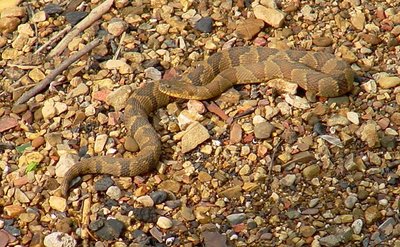
Northern water snake (Nerodia sipedon). Click for a larger picture.
This rocky little beach was the perfect camoflage for him.

I didn't even seen him at first. Then I briefly thought that he was a Copperhead.
I tried going down to the beach to take a closer picture, but he didn't think too much of that idea.
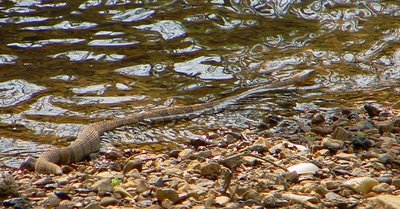
There are four subspecies:
Nerodia sipedon sipedon, Northern water snake
Nerodia sipedon pleuralis, Midland water snake
Nerodia sipedon insularum, Lake Erie water snake
Nerodia sipedon williamengelsi, Carolina water snake
My ancient Audubon reptile book shows only the common sipedon subspecies in this part of Alabama, although some websites suggest there should only be the Midland version here. The pleuralis is supposed to have "dark back markings narrower than spaces between them," which this one does not.
They don't lay eggs, but have live babies instead.

Northern water snake (Nerodia sipedon). Click for a larger picture.
This rocky little beach was the perfect camoflage for him.

I didn't even seen him at first. Then I briefly thought that he was a Copperhead.
I tried going down to the beach to take a closer picture, but he didn't think too much of that idea.

There are four subspecies:
Nerodia sipedon sipedon, Northern water snake
Nerodia sipedon pleuralis, Midland water snake
Nerodia sipedon insularum, Lake Erie water snake
Nerodia sipedon williamengelsi, Carolina water snake
My ancient Audubon reptile book shows only the common sipedon subspecies in this part of Alabama, although some websites suggest there should only be the Midland version here. The pleuralis is supposed to have "dark back markings narrower than spaces between them," which this one does not.
They don't lay eggs, but have live babies instead.
Another look at Grivel and the G20
Dave did a good review earlier of the G20 here earlier:
http://coldthistle.blogspot.com//11/grivels-g20-monopoint.html
Dave's original crampons ended up at the factory after a more than "full use"imo and were replaced. Although I would have assumedby the conditon and the climbs they had been up that Dave had simply worn the G20s out. Nothing lasts forever at teh high end of this sport. Although Dave's G20s are certainly trying!

Dave's original crampon is on top here. Grivel didn't simply dismiss the failure of what I figured was simply a worn out crampon but spent some time and energy to find out why the connecting bar eventually failed and how to fix the problem so it would neverhappen again.
Contrast that to a year long debacle of broken crampons over at BD. Grivel not only recognised there was a problem but engineered a fix in less than 5 months. Something to think about next time you need new gear. I know it turns my head. Click on both pictures to get a better idea of what went into thefull story here.

http://coldthistle.blogspot.com//11/grivels-g20-monopoint.html
Dave's original crampons ended up at the factory after a more than "full use"imo and were replaced. Although I would have assumedby the conditon and the climbs they had been up that Dave had simply worn the G20s out. Nothing lasts forever at teh high end of this sport. Although Dave's G20s are certainly trying!

Dave's original crampon is on top here. Grivel didn't simply dismiss the failure of what I figured was simply a worn out crampon but spent some time and energy to find out why the connecting bar eventually failed and how to fix the problem so it would neverhappen again.
Contrast that to a year long debacle of broken crampons over at BD. Grivel not only recognised there was a problem but engineered a fix in less than 5 months. Something to think about next time you need new gear. I know it turns my head. Click on both pictures to get a better idea of what went into thefull story here.

A few random images

Here are a few shots taken over the last few days. I haven't done a lot of shooting as I have been pretty busy working on other things, but I have gotten out here and there. The image above is a 1/2 second exposure with a short pan upwards from bottom to top. Taken on a day of shooting with my friend Roger (http://www.rogernordstromphoto.blogspot.com/) who was actually my inspiration for this shot. Roger showed me a similar picture that he had taken, so I decided to try one of my own within this stand of pine trees on Old Highway 61.
 (Above: Ice pressure ridge on Wauswaugoning Bay)
(Above: Ice pressure ridge on Wauswaugoning Bay) (Above: Ice, snow and sky)
(Above: Ice, snow and sky) (Above: Ice fisherman and gulls on Wauswaugoning Bay)
(Above: Ice fisherman and gulls on Wauswaugoning Bay)
The Final Scanning Spree!
Ten days ago I began the final push to get the last of the family pictures scanned. This scanning project was actually started in mid-April of last year. Four months later I reported that I was nearly done with my own pictures and my Mother's albums, except for those of my sister's family, which my niece was going to sort and organize. My original goal had been to have them scanned by the end of March of this year. In January she handed the box of pictures over to me but then I got sick and the best laid plans were put aside. . . Only two months behind schedule, but the family picture project is finally finished. Yaaay!
Actual time spent scanning during those ten days was 30 hours and probably just as much time spent doing a final sort of the pictures, trimming them, attaching them to acid free card stock, and adding a brief caption (who was in the picture and a date). This scanning spree generated 1233 image files that now consume 1821mb (1.8gb) of my hard drive. Most of these photos were snapshots 3x5" or smaller so they were each scanned at 600 dpi using the Canon CanoScan LiDE 90 scanner. No color corrections or contrast adjustments were done during scanning. The goal was simply to get them scanned!
After scanning, the completed pages were inserted into plastic protective pages and put into 3-ring binders, which took a few more hours ;-) The albums were delivered to my Mother yesterday afternoon. She was very happy to get them back and I am extremely happy to be done with them!!!
 This picture of my sister, taken in 1954, certainly needs some retouching done on it, which may be beyond my current abilities. Thank goodness, most of the other pictures were in much better condition than this one.
This picture of my sister, taken in 1954, certainly needs some retouching done on it, which may be beyond my current abilities. Thank goodness, most of the other pictures were in much better condition than this one.
 This little cutie, my sister's grandson, graduated from 8th grade tonight. He'll be 15 in October and is now nearly 6' tall. He towers over most of the kids in his class.
This little cutie, my sister's grandson, graduated from 8th grade tonight. He'll be 15 in October and is now nearly 6' tall. He towers over most of the kids in his class.
Actual time spent scanning during those ten days was 30 hours and probably just as much time spent doing a final sort of the pictures, trimming them, attaching them to acid free card stock, and adding a brief caption (who was in the picture and a date). This scanning spree generated 1233 image files that now consume 1821mb (1.8gb) of my hard drive. Most of these photos were snapshots 3x5" or smaller so they were each scanned at 600 dpi using the Canon CanoScan LiDE 90 scanner. No color corrections or contrast adjustments were done during scanning. The goal was simply to get them scanned!
After scanning, the completed pages were inserted into plastic protective pages and put into 3-ring binders, which took a few more hours ;-) The albums were delivered to my Mother yesterday afternoon. She was very happy to get them back and I am extremely happy to be done with them!!!
 This picture of my sister, taken in 1954, certainly needs some retouching done on it, which may be beyond my current abilities. Thank goodness, most of the other pictures were in much better condition than this one.
This picture of my sister, taken in 1954, certainly needs some retouching done on it, which may be beyond my current abilities. Thank goodness, most of the other pictures were in much better condition than this one. This little cutie, my sister's grandson, graduated from 8th grade tonight. He'll be 15 in October and is now nearly 6' tall. He towers over most of the kids in his class.
This little cutie, my sister's grandson, graduated from 8th grade tonight. He'll be 15 in October and is now nearly 6' tall. He towers over most of the kids in his class.
Saturday, October 23, 2010
ANT Truss Bike... Mine!
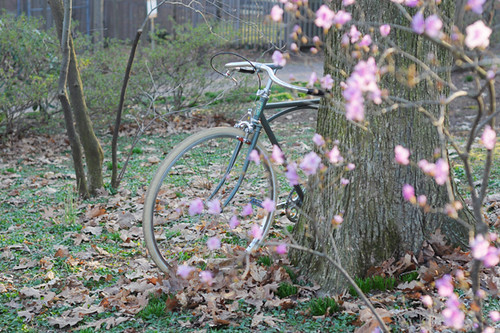
For some time now I've had a trade deal in the works with Mike Flanigan of ANT. In the early stages we discussed what kind of bike it would be, but couldn't decide with certainty. A loop frame with faux lugs? A basket cargo bike? Then one day I knew: a truss frame. And trying one that belonged to a friend cinched that decision.

The truss frame bicycle is a Massachusetts classic, the original having been built by Iver Johnson in 1910 as a pathracer. Mike Flanigan revived the design about a decade ago and made it his own. The basic ANT Truss is what I would call a "civilised recreation" bike: a simple single speed with a reinforced frame, wide tires and low but swept-back handlebars, intended for casual road-to-trail cycling in one's regular clothing. Over the years, the Truss has become one of ANT's signature designs. This, and its relevance to local bicycle manufacturing, is why it appeals to me. I consider this bike to be a ridable collector's item and a piece of local history.
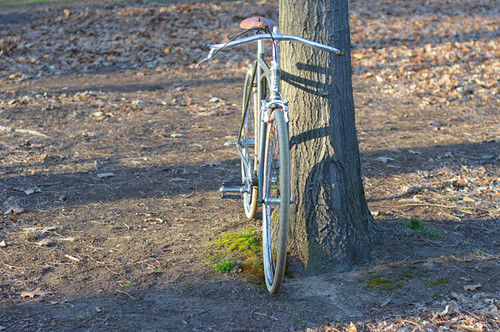
An additional aspect of owning this bike that's interesting to me, is that it is a prototypical ANT and in no way a "collaboration" with me. I merely signed off on features that the builder himself thought best to use. And yet, I like everything about it; I agreed with all the choices Mike made. The bike shows off the shared aspects of mine and the builder's tastes, with neither of us having had to compromise.
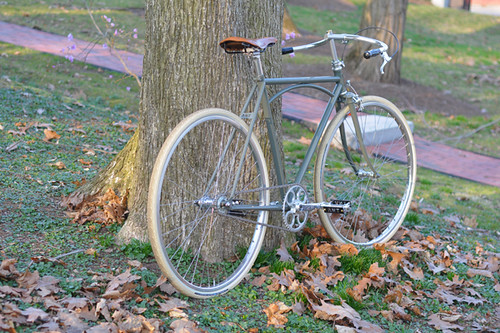
This Truss is a 52cm x 54cm lightweight cro-moly steel frame. It is a hybrid between a classic pathracer and a modern track frame, with a high bottom bracket, aggressive geometry, clearances for 35mm tires, and a generous wheelbase. There is no toe overlap with the 35mm tires. The Eastwood (not RAL) powdercoat is an interesting colour half-way between sage green and slate blue. It looks greenish in the sun, bluish in the shade.
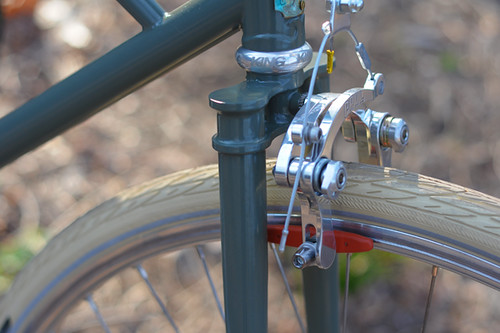
The fork is also handbuilt by Mike Flanigan, with a brazed double-plated fork crown. These forks are Mike's specialty.
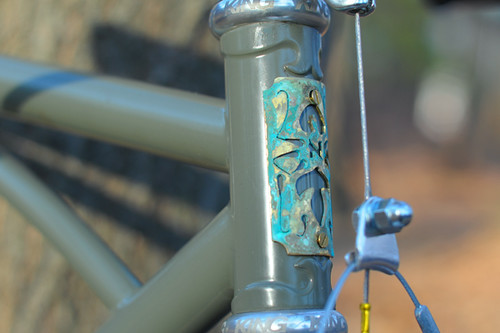
The main tubes are TIG-welded with a superbly smooth finish. The headtube features decorative lugwork. The handmade ANT headbadge was made right in front of me, with the process shown here.
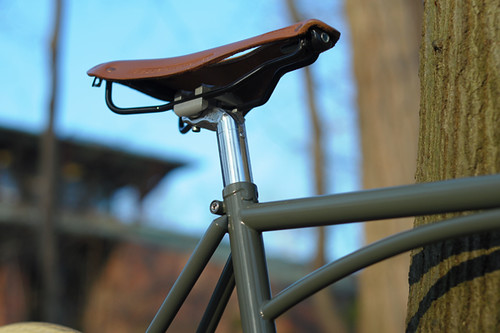
The seat cluster features the signature ANT stays and a lugged collar.
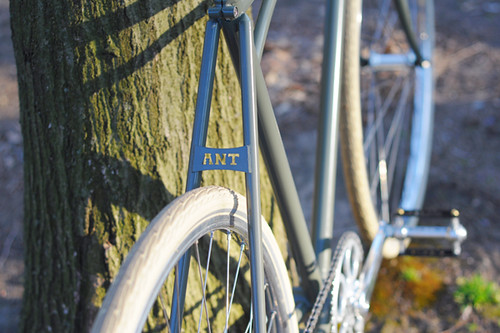
This bike does not require a rear brake bridge, and in its place is a signature ANT plate.

Paul dropouts were used for the rear fork ends.

The stem is handmade by ANT, fitted with Soma Oxford handlebars flipped upside down, a Dia Compe front brake lever, and classic grips from Gripworks.
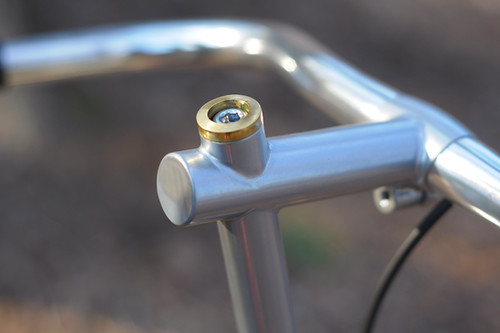
The stem is rather stunningly made and finished, and also one of the builder's specialties.
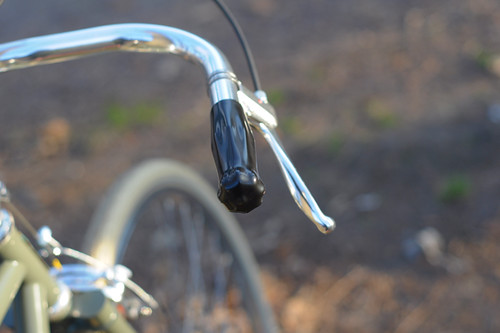
The hard plastic grips are made in Missouri. Gripworks only sells them wholesale in large batches, but Mike has individual pairs available, if anyone is interested. They are very firm to grip, which I prefer to the softer rubber ones. I also like the shape quite a lot - gently fluted and not too thick.
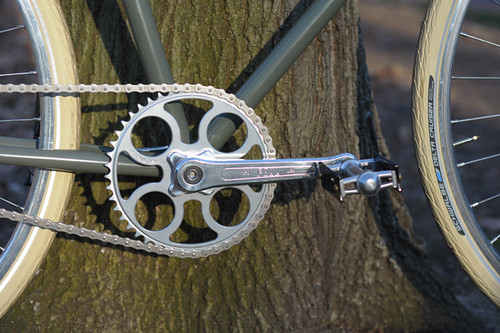
The crankset is Paul's, with 170mm cranks. I love the beautiful circles design and the classic look.
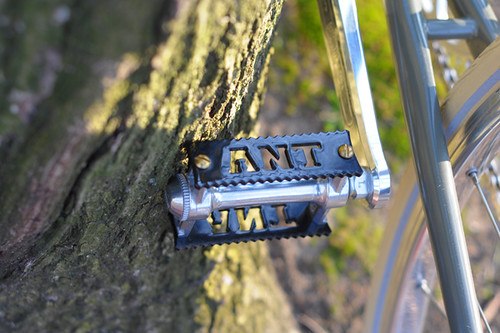
MKS Touring Pedals were customised with ANT cutouts and the cages powdercoated black.

Chris King headset and a Paul centerpull front brake with Kool-Stop pads.
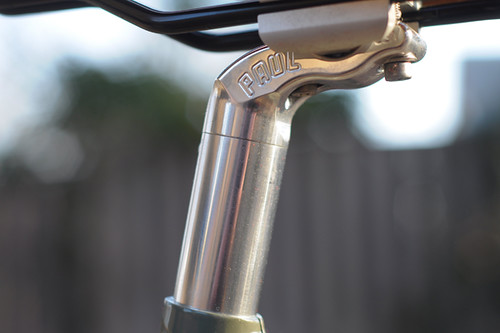
Paul's seatpost with a standard amount of setback.
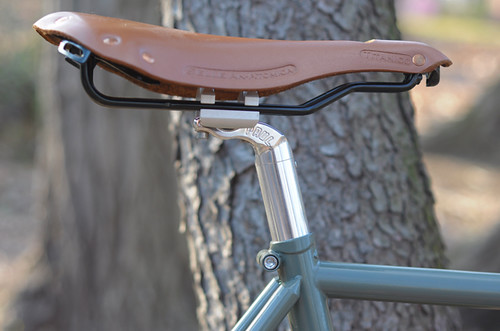
And a Selle Anatomica saddle.
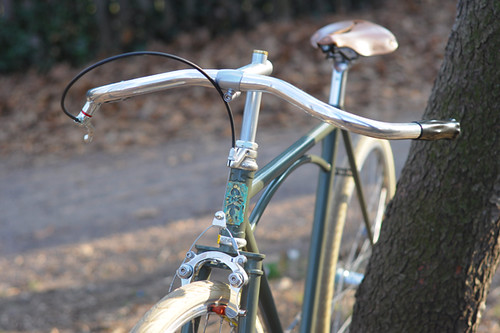
Mike Flanigan prefers to make as many parts of the bike on his own as he can, and to source as many of the remaining components as possible from the US. On this bike Mike made the frame, fork, headbadge, stem, and pedal cages. The headset, crankset, brake,seatpost, saddle, and grips are US-made.
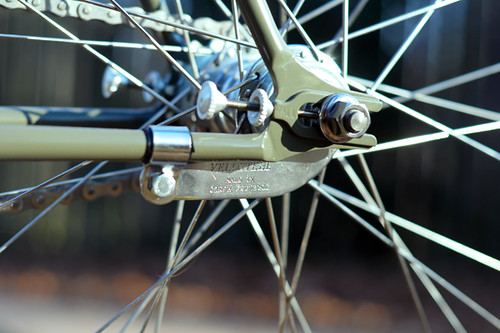
We wanted this bike to be a single speed with free/fixed possibilities, but we agreed that it should not be drilled for a rear brake. So the natural solution was to have two wheelsets: one fixed and one with a coaster brake. We installed the coaster brake wheels to start with and I will probably leave it this way for a while. The rear hub is VeloSteel, made in the Czech Republic. Harris Cyclery built this wheel around a spare Bella Ciao rim I had left over from an earlier project. The front wheel is also a Bella Ciao left-over. The rims are aluminum and made in Germany. My fixed gear wheelset is a very low-end one, but some day I will save up and replace it with one built around Phil Wood hubs, to honor the builder's US-made preferences.
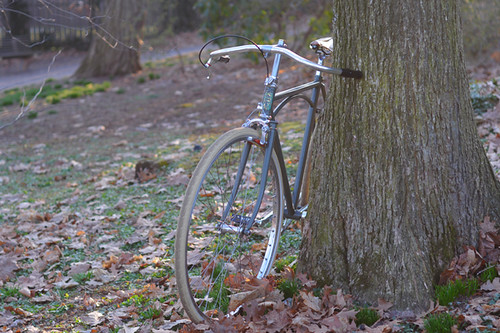
You don't need me to tell you that ANT makes good bikes; Mike has been on the scene for decades and has a legendary reputation without my help. Having known him for three years now, to me Mike is a very real person - creative, independent, open-minded and kind, with great stories and valuable advice. I am fortunate to have been given the opportunity to own one of his bicycles, and I think the unique Truss was the right choice. The bike fits me wonderfully, it rides nicely, and I will surely post more about it as I get to know it better. Full set of pictures here.
Subscribe to:
Posts (Atom)